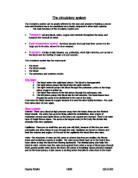Make up of the heart
Four chambers: right and left atrium, right and left ventricle
Ventricles are larger then the atria
Blood is brought back to the heart by veins and carries away from the heart by arteries
The heart is made up of special cells that can carry an electrical impulse called cardiac muscle
Cardiac cycle:
The cardiac cycle consists of two parts: systole – contraction of the heart muscle, diastole – relaxation of the heart muscle
Atriums contract while ventricles relax
Ventricles contract while atriums relax
Heart valves limit flow to a single direction
One heartbeat or cardiac cycle, includes atrial contraction and relaxation, ventricular contraction and relaxation and a short pause
Blood flow through the heart:
Right atrium- deoxygenated blood
Right ventricle- deoxygenated blood
Pulmonary artery- deoxygenated blood
LUNGS- deoxygenated → oxygenated
Pulmonary vein- oxygenated blood
Left ventricle- oxygenated blood
Left atrium- oxygenated blood
Aorta- oxygenated blood to the body
Control of the beat
The sinoatrial node initiates heartbeat causes the artia to contract. The atrioventricular node causes ventricles to contract. The AV node is sometimes called the pacemaker since it keeps heart beat regular
The blood:
Constantly flowing through our bodies
Blood is pumped into your heart
Your blood carries nutrients, water, oxygen, hormones, and waste products to and from your body cells
Has about 6 quarts of blood circulating in your body
Consists of 60% plasma and 40% cells and platelets
Plasma- liquid portion of blood
Cells and platelets:
-red blood cell or erythrocytes
-white blood cells or leukocytes
-platelets (creates clots)
plasma:
90% water and 10% dissolved materials including proteins, glucose, ions, hormones, and gases
acts as a buffer, maintaining pH nears 7.4. plasma contains nutrients, wastes, salts, proteins, etc
red blood cells:
responsible for carrying oxygen and carbon dioxide
pick up oxygen in the lungs and transport it to all the body cells
after delivering the oxygen to the cells it gathers up the carbon dioxide and transports carbon dioxide back to the lungs where it is removed from the body when we exhale
5,000,000 red blood cells in ONE drop of blood
life span Is only 120 days after which they are destroyed in the liver and spleen
white blood cells:
are larger then erythrocytes
have nucleus, but lack hemoglobin
they function in the cellular immune response
white blood cells are less then 1% of the bloods volume
type of WBCs: (five)
Neutrophils enter the tissue fluid by squeezing through capillary walls and phagocytozing foreign substances
Macrophages release white blood cells growth factors, causing a population increase for white blood cells
Lymphocytes fight infection
T-cells attack cells containing viruses
B-cells produce antibodies! Antigen containing complexes are phagocytized by a microphage. White blood cells can squeeze through pores in the capillaries and fight infectious diseases in interstitial areas
Platelets:
Blood cells that help stop bleeding
When we cut ourselves, we have broken a blood vessel and the blood leaks out
In order to plug the holes where blood is leaking from the platelets start to stick to the opening of the damage vessel they attract more platelets, fibers and other blood cells to help form a plug to seal the broken blood vessel
When the platelet plug is completely formed the wound stops bleeding
Platelets survive for 10 days before being removed by the liver and spleen
Hemophilia- inability to clot: bleeders disease
Blood cells are made from bone marrow
Red blood cells are made from red marrow
White blood cells and platelets are made from yellow marrow
Bone marrow is a soft tissue inside of our bones the produce blood cells
Blood vessels:
Arteries: carry blood AWAY from the heart
Capillaries: place where gas is exchanged
Veins: carry blood to the heart
are blood vessels that carry oxygen rich blood AWAY from the heart (aaaa away, arteries)
the aorta, larges artery in body, is almost the diameter of a garden hose
arterial walls are able to expand and contract with the heart as it pushes blood through the body
arterial walls are able to expand and contract
arteries have three layers of thick walls
smooth muscle fibers contract another layer of connective tissue is quite elastic, allowing the arteries to carry blood under high pressure
the aorta is the main artery leaving the heart
the pulmonary artery is the only artery that carries oxygen-poor blood. The pulmonary artery carries deoxygenated blood to the lungs
arterioles are small arteries that connect larger arteries with capillaries –small arterioles branch into collections of capillaries known as capillary beds
tiny blood vessels, only 1 RBC fits through at a time
capillaries are only 1 cell thick
capillaries connect arteries to veins
food substances (nutrients), oxygen, waste pas through the capillary walls
capillaries on the other hand are so small that it tales ten of them to equal the thickness of a human hair
capillaries are thin walled blood vessels in which gas exchange occurs. In the capillary, the wall is only one cell layer thick. Capillaries are concentrated into capillary beds
nutrients, wastes and hormones are exchanged across the thin walls of capillaries
carry blood back towards your heart
veins carry blood from capillaries to the heart with the exception of the pulmonary veins, blood in veins is oxygen-poor. The pulmonary veins carry oxygenated blood from the lungs back to the heart
venules are smaller veins the gather blood from capillary beds into veins
the veins have valves that prevent back flow









